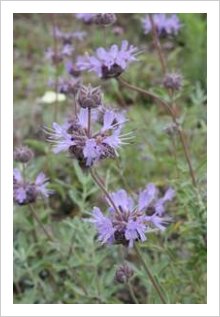Cutting Back Salvias
Lambley Nursery gets lots of questions from customers about cutting back plants to get the best out of them. It is hard to generalise as we treat different plants in different ways. Take Salvias for example.
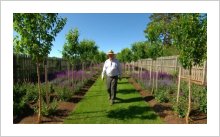 1) The Salvia nemorosa/superba/sylvestris complex is one of the most important groups of plants in my garden both in the mixed plantings in the dry garden and the mass planting in Molly’s Garden. These herbaceous Salvias are cut to the ground and I mean right to the ground twice a year, once in early May (mid autumn) and again in late December (mid-summer).
1) The Salvia nemorosa/superba/sylvestris complex is one of the most important groups of plants in my garden both in the mixed plantings in the dry garden and the mass planting in Molly’s Garden. These herbaceous Salvias are cut to the ground and I mean right to the ground twice a year, once in early May (mid autumn) and again in late December (mid-summer).
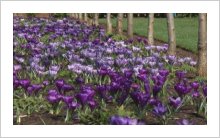 All of our Salvia nemorosa drifts are under planted with bulbs. We have to get the Salvias cut back and cleaned up and any remulching done early as the bulbs start to put their noses out of the ground by mid-May (late autumn). If the Salvias are not cut back by then we are likely to damage the bulbs either by trampling on them or by cutting the emerging foliage. We cut the Salvia nemorosa varieties right to the ground again just after Christmas even though they still have lots of flowers on them and still look fine. If we delay this cutting back to say mid January (mid summer) then we are less likely to get a good second flowering during late summer and autumn.
All of our Salvia nemorosa drifts are under planted with bulbs. We have to get the Salvias cut back and cleaned up and any remulching done early as the bulbs start to put their noses out of the ground by mid-May (late autumn). If the Salvias are not cut back by then we are likely to damage the bulbs either by trampling on them or by cutting the emerging foliage. We cut the Salvia nemorosa varieties right to the ground again just after Christmas even though they still have lots of flowers on them and still look fine. If we delay this cutting back to say mid January (mid summer) then we are less likely to get a good second flowering during late summer and autumn. 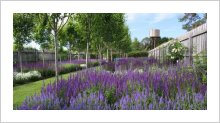 A couple of varieties don’t respond so well to this second cut back; that is they don’t rebloom well. They are Salvia x superb ‘Superba’, which I first saw shining in the Sissinghurst Castle gardens, and Salvia ‘Lye End’ which was raised by Miss Poole who gardened at Lye End and is most renowned for raising Achillea ‘Coronation Gold’. Treating this group of Salvias in this way means we have them flowering for twenty weeks in a gardening year.
A couple of varieties don’t respond so well to this second cut back; that is they don’t rebloom well. They are Salvia x superb ‘Superba’, which I first saw shining in the Sissinghurst Castle gardens, and Salvia ‘Lye End’ which was raised by Miss Poole who gardened at Lye End and is most renowned for raising Achillea ‘Coronation Gold’. Treating this group of Salvias in this way means we have them flowering for twenty weeks in a gardening year.
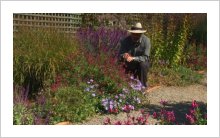 2) We treat the shrubby and twiggy Salvia greggii/microphylla and closely associated species and hybrids quite differently. At Lambley these are pruned or, more accurately, clipped during late autumn and early winter. We use hedge shears to do this and just cut about a third of the growth off making a ball like shape. This shape gives some architectural interest during winter. Growth soon recommences in spring and flowering is well underway by Christmas.
2) We treat the shrubby and twiggy Salvia greggii/microphylla and closely associated species and hybrids quite differently. At Lambley these are pruned or, more accurately, clipped during late autumn and early winter. We use hedge shears to do this and just cut about a third of the growth off making a ball like shape. This shape gives some architectural interest during winter. Growth soon recommences in spring and flowering is well underway by Christmas.
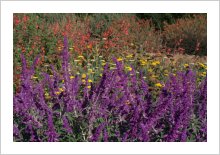 3) Salvia leucantha and its hybrids and Salvia mexicana clones flower with us until the first frosts. We then cut them to the ground and generally mulch them to protect the roots over winter. As we get late frosts here right into November (late spring) regrowth doesn’t really get going until early summer. These plants flower for us only during February, March and April (late summer-autumn) whilst in warmer areas they flower nearly the whole year round. Even if they are still in flower for you during late winter it is probably as well to cut them to the ground so that you get a fresh start each year as all the old daggy stems are removed.
3) Salvia leucantha and its hybrids and Salvia mexicana clones flower with us until the first frosts. We then cut them to the ground and generally mulch them to protect the roots over winter. As we get late frosts here right into November (late spring) regrowth doesn’t really get going until early summer. These plants flower for us only during February, March and April (late summer-autumn) whilst in warmer areas they flower nearly the whole year round. Even if they are still in flower for you during late winter it is probably as well to cut them to the ground so that you get a fresh start each year as all the old daggy stems are removed.
4) Salvia ‘Celestial Blue’ ‘Allen Chittering’ ‘Bee’s Bliss’ are all hybrids or selections of Salvia clevelandii. They are evergreen or rather ever-grey shrubs grown as much for foliage effect as for their whorls of lovely mauve-blue flowers. We don’t prune this group in winter as they flower on the previous season’s wood so winter pruning would seriously effect flowering. We do tidy them up when blooming is finished but this doesn’t entail any drastic pruning just cutting off errant growth and spent flowering stems. The dramatic grey foliaged shrub, Salvia apiana, with its 150cm tall flower stems is treated similarly.
